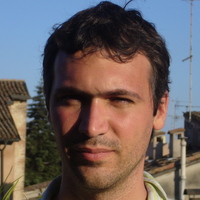
lorenzo bosi
My main research interests have been on political sociology and historical sociology where my studies have primarily focused on social movements and political violence.
less
Related Authors
Stefan Malthaner
Leuphana University
Måns Lundstedt
University of Gothenburg
Gianluca De Fazio
James Madison University
Francis O Connor
Peace Research Institute Frankfurt
Martín Portos
Universidad Carlos III de Madrid
guya accornero
ISCTE - University Institute of Lisbon (ISCTE-IUL)
Olivier Fillieule
University of Lausanne
Francis O Connor
Peace Research Institute Frankfurt
Rune Ellefsen
University of Oslo
InterestsView All (41)









Uploads
Papers by lorenzo bosi
is no academic investigation into how and when this happens. This article does
so focusing on direct social action, that is, a form of collective action that does
not primarily focus upon claiming something from the state but instead focuses upon
directly transforming some specific aspects of society. Building on conceptual categories
developed by social movements’ scholars (context, organization, and identity)
and relying on rich qualitative and quantitative data from collective actors in Italy in a
time of crisis, this article identifies four paths toward direct social actions (DSA): the
social path, the political-social path, the social-political path, and the political path. In
doing so, our analysis shifts from the search for causal factors to the reconstruction
of the dynamic, patterned sequences of events by which collective actors progress
in adopting a certain form of action. The implications of these findings extend beyond
studies of DSA in times of crisis in Italy, to an analysis of collective action in general.
Capturing these multiple paths also has important implications for understanding how
the same form of action is differently implemented and received when it is adopted by
different actors.
motivated by the enactment of an identity that people already have prior
to their mobilization as a way to strongly assert and emphasize individual
agency in the face of major changes in the political context. Empirically,
it advocates that those who joined the Provisional IRA between 1969 and
1972 did so in order to respond to a need for action by a northern nationalist
community that stemmed from a perceived, alleged or actual, sense of
second-class citizenship. We suggest that the importance of identity rather
than ideology can also help us to explain why IRA members and former
members overwhelmingly accepted the compromise peace settlement of
the 1990s despite the fact that core ideological goals had not been realized.
We conclude by suggesting avenues for future research outside the Irish
context.
strands of the same social movements as a window onto the role played by agency in this process. It
presents a paired comparison of two very different transformative events in twentieth-century Ireland —
the Easter Rising of 1916 and the Long March from Belfast to Derry in 1969 — and the strategic
interactions preceding them. The comparison shows how agency and structure can interface around
transformative events: high levels of agency were instrumental in making the events; but while the events
brought powerful structural forces to the boil, those forces might well have remained dormant had it not
been for that initial agency. We also see that the balance between structure and agency is dynamic,
sometimes shifting from one moment to another rather than remaining constant.
is no academic investigation into how and when this happens. This article does
so focusing on direct social action, that is, a form of collective action that does
not primarily focus upon claiming something from the state but instead focuses upon
directly transforming some specific aspects of society. Building on conceptual categories
developed by social movements’ scholars (context, organization, and identity)
and relying on rich qualitative and quantitative data from collective actors in Italy in a
time of crisis, this article identifies four paths toward direct social actions (DSA): the
social path, the political-social path, the social-political path, and the political path. In
doing so, our analysis shifts from the search for causal factors to the reconstruction
of the dynamic, patterned sequences of events by which collective actors progress
in adopting a certain form of action. The implications of these findings extend beyond
studies of DSA in times of crisis in Italy, to an analysis of collective action in general.
Capturing these multiple paths also has important implications for understanding how
the same form of action is differently implemented and received when it is adopted by
different actors.
motivated by the enactment of an identity that people already have prior
to their mobilization as a way to strongly assert and emphasize individual
agency in the face of major changes in the political context. Empirically,
it advocates that those who joined the Provisional IRA between 1969 and
1972 did so in order to respond to a need for action by a northern nationalist
community that stemmed from a perceived, alleged or actual, sense of
second-class citizenship. We suggest that the importance of identity rather
than ideology can also help us to explain why IRA members and former
members overwhelmingly accepted the compromise peace settlement of
the 1990s despite the fact that core ideological goals had not been realized.
We conclude by suggesting avenues for future research outside the Irish
context.
strands of the same social movements as a window onto the role played by agency in this process. It
presents a paired comparison of two very different transformative events in twentieth-century Ireland —
the Easter Rising of 1916 and the Long March from Belfast to Derry in 1969 — and the strategic
interactions preceding them. The comparison shows how agency and structure can interface around
transformative events: high levels of agency were instrumental in making the events; but while the events
brought powerful structural forces to the boil, those forces might well have remained dormant had it not
been for that initial agency. We also see that the balance between structure and agency is dynamic,
sometimes shifting from one moment to another rather than remaining constant.
We welcome panel proposals from a wide variety of perspectives that apply, or reflect on, competing interpretive approaches to political violence, including, but not limited to:
- Rationalist interpretations;
- Cultural interpretations;
- Social Movements Studies interpretations;
- Gender Studies interpretations;
- Geographical interpretations;
- Security/counter-insurgency interpretations;
The section aims to bring together distinguished scholars and younger researchers not only from political science, but from related disciplines, including economics, sociology, geography, anthropology, psychology, historical science, international relations, and area studies. In organising this section we seek to further the development of research on political violence in Europe and globally, to contribute to the further development of an international network of scholars working in this field and to promote the publication of outputs such as co-edited books or special issues of international journals.
lotta armata? Qual è la loro esperienza e cosa sostiene il loro impegno all’interno
dei gruppi armati, anche a fronte di lunghi periodi di prigionia? Come
escono dalla lotta armata e quali conseguenze sulla loro storia di vita attribuiscono
a quella scelta? Il libro risponde a queste domande basandosi su venticinque
testimonianze di donne e uomini che fra il 1969 e il 1972, in Nord Irlanda,
entrarono a far parte della Provisional Irish Republican Army.
Chapters of original research emphasize how the processes of radicalization and violence are open-ended, interactive, and context dependent. They offer detailed empirical accounts as well as comprehensive and systematic analyses of the dynamics leading to violent episodes. Specifically, the chapters converge around four dynamic processes that are shown to be especially germane to radicalization and violence: dynamics of movement-state interaction; dynamics of intra-movement competition; dynamics of meaning formation and transformation; and dynamics of diffusion.
Contents: A contentious politics approach to the explanation of radicalization, Lorenzo Bosi, Chares Demetriou and Stefan Malthaner. Part I Dynamics of Interaction between Oppositional Movements/Groups and the State: The mechanisms of emotion in violent protest, Hank Johnston; A typology of backfire mechanisms, Lasse Lindekilde; Processes of radicalization and de-radicalization in Western European prisons (1965-1986), Christian G. De Vito. Part II Competition and Conflict: Dynamics of Intra-Movement Interaction: Competitive escalation during protest cycles: comparing left-wing and religious conflicts, Donatella della Porta; Intra-movement competition and political outbidding as mechanisms of radicalization in Northern Ireland, 1968-1969, Gianluca De Fazio; The limits of radicalization: escalation and restraint in the South African liberation movement, Devashree Gupta. Part III Dynamics of Meaning Formation: Frames and Beyond: Contentious interactions, dynamics of interpretations, and radicalization: the Islamization of Palestinian nationalism, Eitan Y. Alimi and Hank Johnston; Radical or righteous? Using gender to shape public perceptions of political violence, Jocelyn Viterna; From national event to transnational injustice symbol: the three phases of the Muhammad cartoon controversy, Thomas Olesen. Part IV Dynamics of (Transnational) Diffusion: Radicalization from outside: the role of the anarchist diaspora in coordinating armed actions in Franco’s Spain, Eduardo Romanos; Protest diffusion and rising political violence in the Turkish ’68 movement: the Arab-Israeli war, ‘Paris May’ and the hot summer of 1968, Emin Alper; The evolution of the al-Qaeda-type terrorism: networks and beyond, Ekaterina Stepanova; Conclusion, Martha Crenshaw; Index.